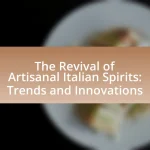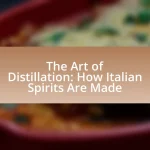Grappa is a traditional Italian spirit originating from Northern Italy, made from the pomace of grapes and deeply rooted in the region’s winemaking history. The article explores Grappa’s significance as a cultural symbol, its traditional production methods, and the key ingredients involved in its creation. It also examines the evolution of Grappa production over time, influenced by historical events and modern distillation techniques, as well as current trends and future prospects in the market. Additionally, the article highlights regional variations, innovative flavors, and best practices for enjoying Grappa, emphasizing its role in Italian culinary traditions.

What is Grappa and its significance in Northern Italy?
Grappa is a traditional Italian spirit made from the pomace of grapes, primarily produced in Northern Italy. Its significance in this region stems from its historical roots in winemaking, where it originated as a way to utilize leftover grape skins, seeds, and stems after the fermentation process. Grappa has been recognized as a distinct product since the 19th century, and its production is regulated under Italian law, which requires it to be made from Italian grapes. This spirit embodies the cultural heritage of Northern Italy, reflecting local agricultural practices and regional identities, and is often enjoyed as a digestif, symbolizing hospitality and tradition in Italian society.
How is Grappa traditionally made?
Grappa is traditionally made by distilling the pomace, which consists of grape skins, seeds, and stems left over after winemaking. The process begins with the collection of fresh pomace, which is then fermented to convert residual sugars into alcohol. Following fermentation, the pomace is distilled in a pot still or column still, where the alcohol is separated from the solids and impurities. This distillation process typically occurs at a low temperature to preserve the aromatic compounds of the grapes. The resulting spirit is then aged in wooden barrels or left unaged, depending on the desired flavor profile. This traditional method has been practiced in Northern Italy for centuries, reflecting the region’s winemaking heritage.
What are the key ingredients used in Grappa production?
The key ingredients used in Grappa production are pomace, which is the solid remains of grapes after pressing, and water. Pomace is essential as it contains the skins, seeds, and stems of the grapes, providing the primary flavor and alcohol content during distillation. Water is added to adjust the alcohol level and enhance the final product’s smoothness. Grappa is traditionally made from the pomace of specific grape varieties, often sourced from Northern Italy, where the practice has historical roots dating back to the 15th century.
What methods are employed in the distillation of Grappa?
The primary methods employed in the distillation of Grappa are pot still distillation and continuous column distillation. Pot still distillation involves heating the fermented grape pomace in a traditional copper pot still, allowing for the separation of alcohol from the solids, while continuous column distillation utilizes a column still for a more efficient and continuous process, producing a higher alcohol content. Both methods are integral to the production of Grappa, with pot stills often used for artisanal varieties, ensuring a rich flavor profile, and column stills favored for larger-scale production, resulting in a cleaner spirit.
Why is Grappa considered a cultural symbol in Northern Italy?
Grappa is considered a cultural symbol in Northern Italy due to its deep-rooted history and significance in local traditions. Originating from the distillation of grape pomace, grappa reflects the region’s winemaking heritage, particularly in areas like Piedmont and Veneto, where it has been produced for centuries. The drink is often associated with Italian hospitality and is traditionally served as a digestif, embodying the values of family and community gatherings. Furthermore, grappa’s recognition as a Protected Geographical Indication (PGI) since 1997 underscores its cultural importance and authenticity, solidifying its status as a symbol of Northern Italian identity.
How does Grappa reflect the traditions of Northern Italian regions?
Grappa reflects the traditions of Northern Italian regions through its production methods, local grape varieties, and cultural significance. Originating from the practice of distilling pomace, the leftover grape skins, seeds, and stems after winemaking, Grappa embodies the resourcefulness and agricultural heritage of these regions. Each area, such as Piedmont, Veneto, and Friuli-Venezia Giulia, contributes unique grape varieties, which influence the flavor profiles of the Grappa produced there, showcasing local terroir. Additionally, Grappa is often consumed as a digestif, highlighting its role in social and familial gatherings, thus reinforcing community bonds and regional identity. The Italian government has also recognized Grappa as a Protected Geographical Indication (PGI), further solidifying its cultural and historical importance in Northern Italy.
What role does Grappa play in Italian culinary practices?
Grappa serves as a traditional Italian digestif, often consumed after meals to aid digestion. This role is rooted in Italian culinary practices, where it is typically enjoyed neat or in coffee, enhancing the dining experience. Historically, grappa has been made from the pomace of grapes, reflecting the Italian ethos of minimizing waste in food production. Its use in culinary practices is also evident in modern Italian cuisine, where it is incorporated into sauces and desserts, showcasing its versatility and cultural significance.

How has the production of Grappa evolved over time?
The production of Grappa has evolved significantly from its origins in the 15th century to modern times. Initially, Grappa was a rustic spirit made by distilling pomace, the leftover grape skins, seeds, and stems after winemaking, primarily in Northern Italy. Over the centuries, advancements in distillation techniques, such as the introduction of pot stills and later column stills, improved the quality and efficiency of Grappa production. By the late 20th century, the establishment of strict regulations and quality standards, including the designation of Grappa as a Protected Geographical Indication (PGI) in 1997, further refined its production methods and elevated its status as a premium spirit. Today, Grappa is produced with a focus on craftsmanship, using specific grape varieties and innovative aging processes, reflecting both tradition and modernity in its production.
What historical events influenced Grappa production?
The production of Grappa has been significantly influenced by several historical events, particularly the introduction of distillation techniques in the Middle Ages. The establishment of the first distilleries in Italy during the 14th century marked a pivotal moment, as it allowed for the transformation of grape pomace into a distilled spirit. Additionally, the economic hardships faced by Italian farmers in the 19th century, particularly after the phylloxera epidemic devastated vineyards, led to an increased focus on utilizing all parts of the grape, including pomace, for Grappa production. This practice not only provided a means of economic survival but also contributed to the cultural identity of the region. Furthermore, the legal recognition of Grappa as a distinct product in the 20th century, particularly with the establishment of the Denominazione di Origine Controllata (DOC) regulations in 1997, solidified its status and quality, further influencing its production methods and market presence.
How did the introduction of modern distillation techniques change Grappa?
The introduction of modern distillation techniques significantly improved the quality and consistency of Grappa. These techniques, such as vacuum distillation and continuous column distillation, allowed for more precise control over the distillation process, resulting in a purer and more refined spirit. For instance, vacuum distillation lowers the boiling point, preserving delicate aromas and flavors that traditional methods might lose. This advancement has led to a broader acceptance of Grappa in the global market, enhancing its reputation as a premium product rather than a simple byproduct of winemaking.
What impact did globalization have on Grappa’s popularity?
Globalization significantly increased Grappa’s popularity by expanding its market beyond Italy. As international trade and cultural exchange grew, Grappa gained recognition as a premium Italian spirit, appealing to global consumers seeking authentic experiences. The rise of Italian cuisine worldwide, particularly in the late 20th century, further propelled Grappa’s visibility, with exports increasing from approximately 1.5 million liters in the 1990s to over 3 million liters by 2020, according to the Italian Ministry of Agricultural, Food and Forestry Policies. This surge in demand reflects globalization’s role in transforming Grappa from a regional product into a globally appreciated beverage.
What are the different styles of Grappa produced today?
The different styles of Grappa produced today include young Grappa, aged Grappa, flavored Grappa, and Grappa di monovitigno. Young Grappa, known as “Grappa giovane,” is unaged and has a fresh, fruity character. Aged Grappa, or “Grappa invecchiata,” is matured in wooden barrels, which imparts complex flavors and a smoother texture. Flavored Grappa, often infused with herbs, fruits, or spices, offers unique taste profiles. Grappa di monovitigno is made from a single grape variety, showcasing the specific characteristics of that grape. These styles reflect the diverse production methods and regional variations in Northern Italy, where Grappa originated.
How do aging processes affect the flavor profiles of Grappa?
Aging processes significantly enhance the flavor profiles of Grappa by allowing the spirit to interact with wood barrels, which imparts complex flavors and aromas. During aging, compounds from the wood, such as vanillin and tannins, are absorbed, contributing notes of vanilla, spice, and oak. Additionally, the oxidation that occurs during aging softens the harsher alcohol notes, resulting in a smoother and more rounded flavor. Research indicates that the duration of aging directly correlates with flavor complexity; for instance, Grappa aged for longer periods can develop richer, more nuanced profiles compared to younger varieties. This transformation is supported by the traditional practices in Northern Italy, where specific aging techniques have been refined over centuries to enhance the sensory experience of Grappa.
What are the regional variations of Grappa in Northern Italy?
Grappa in Northern Italy exhibits distinct regional variations, primarily influenced by local grape varieties and production methods. For instance, in the Veneto region, Grappa is often made from the pomace of Prosecco grapes, resulting in a lighter, floral flavor profile. In contrast, the Trentino-Alto Adige region produces Grappa using a variety of local grapes, such as Gewürztraminer, leading to a more aromatic and complex spirit. Additionally, in Friuli Venezia Giulia, Grappa is known for its smoothness and is frequently distilled using traditional methods, emphasizing the quality of the grape pomace. These regional differences are rooted in the unique agricultural practices and cultural traditions of each area, contributing to the diverse landscape of Grappa production in Northern Italy.

What are the current trends and future prospects for Grappa?
Current trends for Grappa include a growing interest in artisanal production methods and premium quality offerings, as consumers increasingly seek authentic and high-quality spirits. The rise of craft distilleries in Italy has led to innovative flavor profiles and unique expressions of Grappa, appealing to a younger demographic. Future prospects for Grappa appear positive, with market research indicating a projected growth rate of 5.2% annually in the global Grappa market through 2027, driven by increased international awareness and appreciation for this traditional Italian spirit. This growth is supported by initiatives to promote Grappa as a versatile ingredient in cocktails and culinary applications, enhancing its visibility and consumption beyond traditional settings.
How is Grappa being marketed to new generations?
Grappa is being marketed to new generations through innovative branding, social media engagement, and the promotion of craft distillation. Distilleries are emphasizing artisanal production methods and unique flavor profiles to attract younger consumers who value authenticity and quality. For instance, brands are leveraging platforms like Instagram to showcase visually appealing cocktails and the distillation process, thereby creating a lifestyle around Grappa that resonates with millennials and Gen Z. Additionally, collaborations with mixologists and participation in trendy bars and restaurants help position Grappa as a versatile spirit suitable for modern cocktails, further enhancing its appeal to a younger audience.
What innovative flavors and blends are emerging in the Grappa market?
Innovative flavors and blends emerging in the Grappa market include fruit-infused varieties, herbal blends, and barrel-aged options. Producers are experimenting with infusions of fruits like raspberry and apricot, which enhance the traditional grape base with new aromatic profiles. Additionally, herbal blends incorporating botanicals such as rosemary and sage are gaining popularity, appealing to consumers seeking unique taste experiences. Barrel-aging techniques are also evolving, with some distillers using different types of wood, such as cherry or chestnut, to impart distinct flavors and complexity to the spirit. These trends reflect a broader movement towards artisanal and craft production in the Grappa industry, catering to a growing demand for innovative and diverse flavor profiles.
How are producers adapting to changing consumer preferences?
Producers of grappa in Northern Italy are adapting to changing consumer preferences by diversifying their product offerings and emphasizing quality and sustainability. For instance, many producers are now creating flavored grappas and organic options to cater to the growing demand for unique and artisanal spirits. Additionally, they are investing in modern marketing strategies, including social media engagement, to reach younger consumers who prioritize authenticity and craftsmanship. This shift is supported by market research indicating that premium spirits, including artisanal grappas, have seen a significant increase in sales, reflecting a broader trend towards high-quality, locally sourced products.
What are the best practices for enjoying and serving Grappa?
The best practices for enjoying and serving Grappa include serving it at room temperature in a small glass, typically a tulip-shaped glass, to enhance its aromatic qualities. Grappa should be sipped slowly to appreciate its complex flavors, which can range from fruity to herbal, depending on the grape variety used. Additionally, pairing Grappa with food, such as dark chocolate or strong cheeses, can elevate the tasting experience. Historically, Grappa has been consumed as a digestif in Italy, reinforcing its role in culinary traditions.
What food pairings enhance the experience of drinking Grappa?
Grappa pairs well with rich cheeses, dark chocolate, and dried fruits, enhancing its complex flavors. The boldness of aged cheeses like Parmigiano-Reggiano or Gorgonzola complements the spirit’s intensity, while dark chocolate provides a contrasting sweetness that balances Grappa’s sharpness. Dried fruits, such as figs or apricots, add a natural sweetness that harmonizes with Grappa’s aromatic profile. These pairings are rooted in Italian culinary traditions, where Grappa is often enjoyed as a digestif after meals, making them culturally relevant and enhancing the overall tasting experience.
How should Grappa be served for optimal enjoyment?
Grappa should be served at room temperature in a tulip-shaped glass to enhance its aromatic qualities. This glass shape concentrates the aromas, allowing for a more enjoyable sensory experience. Serving Grappa at room temperature, typically between 16-18 degrees Celsius, ensures that the complex flavors are fully expressed, as colder temperatures can mute its characteristics. Additionally, it is often recommended to sip Grappa slowly to appreciate its depth and nuances, which is consistent with traditional Italian customs surrounding this spirit.










